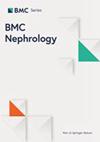The risk of thromboembolic events in patients with nephrotic syndrome and relatively high albumin levels: a study over 10 years
IF 2.2
4区 医学
Q2 UROLOGY & NEPHROLOGY
引用次数: 0
Abstract
Low albumin level is a risk factor for thromboembolic events in patients with NS (nephrotic syndrome). However, little is known about the proportion and characteristics of patients with NS who experience thromboembolic events with relatively high albumin levels (≥ 25 g/L). Therefore, we explored the features of this specific group of patients. This study included all hospitalized patients in our center for the past 10 years who had diagnoses of NS and relevant thromboembolic events. We divided them into 2 groups based on their serum albumin level when the thromboembolic event occurred. The clinical data were analyzed with SPSS software. There were 312 patients enrolled in our study. Eighty-four (26.9%) of them had relatively high albumin levels (≥ 25 g/L). Patients with NS with high albumin levels had significantly lower levels of 24-h proteinuria (P < 0.01) and a higher rate of autoimmune disease (P = 0.03) than the low-albumin group. Membranous nephropathy (MN) was the most frequent pathological type of NS in patients with thromboembolic events, regardless of their albumin level. There were significantly fewer patients with anti-PLA2R (M-type phospholipase A2 receptor)-positive MN in the high-albumin group than in the low-albumin group (P < 0.01). Our study found that there was still a high risk for patients with NS and relatively high albumin levels to develop thromboembolic events.肾病综合征和白蛋白水平相对较高的患者发生血栓栓塞事件的风险:一项历时 10 年的研究
白蛋白水平低是 NS(肾病综合征)患者发生血栓栓塞事件的一个危险因素。然而,人们对白蛋白水平相对较高(≥ 25 g/L)的 NS 患者发生血栓栓塞事件的比例和特征知之甚少。因此,我们探讨了这一特殊患者群体的特征。本研究纳入了本中心过去 10 年中所有诊断为 NS 并发生相关血栓栓塞事件的住院患者。我们根据血栓栓塞事件发生时的血清白蛋白水平将他们分为两组。临床数据采用 SPSS 软件进行分析。共有 312 名患者参与了我们的研究。其中 84 例(26.9%)患者的白蛋白水平相对较高(≥ 25 g/L)。与低白蛋白组相比,高白蛋白水平的NS患者的24小时蛋白尿水平明显较低(P < 0.01),自身免疫性疾病的发病率较高(P = 0.03)。无论白蛋白水平如何,膜性肾病(MN)都是血栓栓塞患者最常见的NS病理类型。高白蛋白组中抗PLA2R(M型磷脂酶A2受体)阳性的MN患者明显少于低白蛋白组(P < 0.01)。我们的研究发现,白蛋白水平相对较高的 NS 患者发生血栓栓塞事件的风险仍然很高。
本文章由计算机程序翻译,如有差异,请以英文原文为准。
求助全文
约1分钟内获得全文
求助全文
来源期刊

BMC Nephrology
UROLOGY & NEPHROLOGY-
CiteScore
4.30
自引率
0.00%
发文量
375
审稿时长
3-8 weeks
期刊介绍:
BMC Nephrology is an open access journal publishing original peer-reviewed research articles in all aspects of the prevention, diagnosis and management of kidney and associated disorders, as well as related molecular genetics, pathophysiology, and epidemiology.
 求助内容:
求助内容: 应助结果提醒方式:
应助结果提醒方式:


